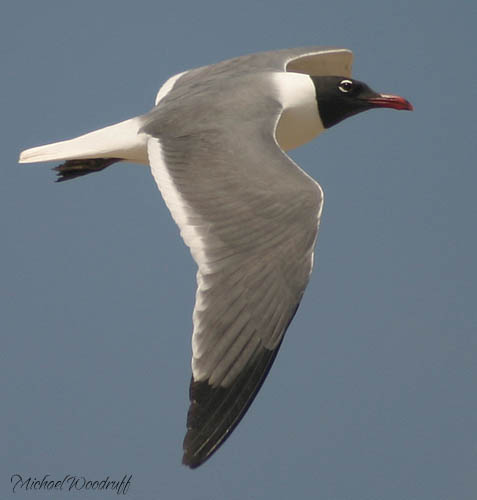m |
|||
| Line 1: | Line 1: | ||
;Larus atricilla | ;Larus atricilla | ||
| − | [[Image:Laughing_Gull.jpg|thumb| | + | [[Image:Laughing_Gull.jpg|thumb|550px|right|Photo by Michael Woodruff]] |
| − | == | + | |
| − | + | ==Identification== | |
| − | == | + | Photographed at the Brownsville Sanitary Landfill in South Texas, USA. April 2004. |
| + | |||
| + | ==Distribution== | ||
Breeds on the east coast of North America from Florida north to Nova Scotia, disperses from breeding areas July-August and begins to move south in mid-August. Winters from North Carolina southwards, returning north in mid-March to mid-May. | Breeds on the east coast of North America from Florida north to Nova Scotia, disperses from breeding areas July-August and begins to move south in mid-August. Winters from North Carolina southwards, returning north in mid-March to mid-May. | ||
Vagrant to many Western Palearctic countries including Iceland and the British Isles, France, the Netherlands and Scandinavia, Poland, Germany and Austria, Greece, Iberia, Morocco, the Canaries and Azores. The majority occur in Britain (c.96 records), recorded in all months and scattered throughout the country, lacking the strong south-westerly bias seen with most Nearctic vagrants. Records include many long-staying, wandering and returning individuals and one German record involved a bird displaying in a Black-headed Gull colony. | Vagrant to many Western Palearctic countries including Iceland and the British Isles, France, the Netherlands and Scandinavia, Poland, Germany and Austria, Greece, Iberia, Morocco, the Canaries and Azores. The majority occur in Britain (c.96 records), recorded in all months and scattered throughout the country, lacking the strong south-westerly bias seen with most Nearctic vagrants. Records include many long-staying, wandering and returning individuals and one German record involved a bird displaying in a Black-headed Gull colony. | ||
| − | + | ==Taxonomy== | |
| − | == | + | ==Habitat== |
| − | Habitat | ||
Breeds on low, flat coastal islands, saltmarshes and sand-dunes. Out of the breeding season mainly coastal on sandy beaches and estuaries, sometimes inland and follows the plough. Also follows ships and sometimes seen far out to sea. | Breeds on low, flat coastal islands, saltmarshes and sand-dunes. Out of the breeding season mainly coastal on sandy beaches and estuaries, sometimes inland and follows the plough. Also follows ships and sometimes seen far out to sea. | ||
| − | == | + | ==Behaviour== |
| − | |||
==External Links== | ==External Links== | ||
*[http://www.birdforum.net/pp_gallery/showgallery.php?mcats=all&what=allfields&si=Larus+atricilla View more images of Laughing Gull in the gallery] | *[http://www.birdforum.net/pp_gallery/showgallery.php?mcats=all&what=allfields&si=Larus+atricilla View more images of Laughing Gull in the gallery] | ||
[[Category:Birds]] | [[Category:Birds]] | ||
Revision as of 17:34, 13 June 2007
- Larus atricilla
Identification
Photographed at the Brownsville Sanitary Landfill in South Texas, USA. April 2004.
Distribution
Breeds on the east coast of North America from Florida north to Nova Scotia, disperses from breeding areas July-August and begins to move south in mid-August. Winters from North Carolina southwards, returning north in mid-March to mid-May.
Vagrant to many Western Palearctic countries including Iceland and the British Isles, France, the Netherlands and Scandinavia, Poland, Germany and Austria, Greece, Iberia, Morocco, the Canaries and Azores. The majority occur in Britain (c.96 records), recorded in all months and scattered throughout the country, lacking the strong south-westerly bias seen with most Nearctic vagrants. Records include many long-staying, wandering and returning individuals and one German record involved a bird displaying in a Black-headed Gull colony.
Taxonomy
Habitat
Breeds on low, flat coastal islands, saltmarshes and sand-dunes. Out of the breeding season mainly coastal on sandy beaches and estuaries, sometimes inland and follows the plough. Also follows ships and sometimes seen far out to sea.




